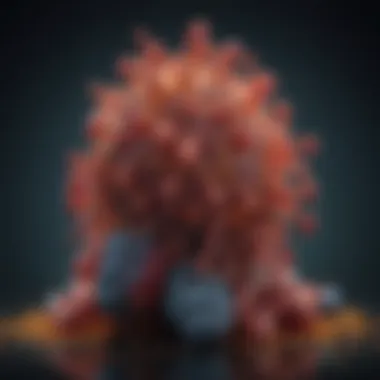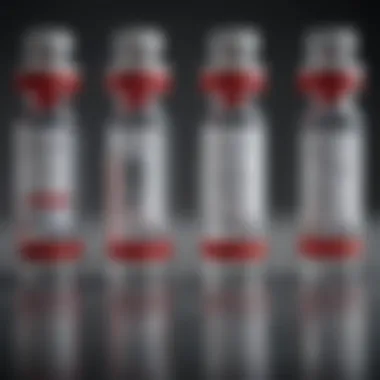The Duration of Vaccine Antibodies: Insights and Impacts


Intro
The immune system, a complex network of cells and proteins, plays a vital role in defending the body against infections. Among the key players in this defense are antibodies. Vaccines, in particular, are engineered to stimulate the production of these antibodies, providing the body with a memorable combat strategy against specific pathogens. However, a crucial question arises: how long do vaccine antibodies last? Understanding the duration of these antibodies not only aids in personal health decisions but also influences public health policies.
In light of ongoing research and varying vaccine formulations, it becomes imperative to dissect the dynamics of antibody longevity. The implications reach far beyond individual immunity; they touch upon herd immunity and vaccine effectiveness in the long haul. The following sections will explore the current scientific findings in this area, shedding light on factors influencing antibody persistence and the rationale behind booster vaccinations.
Understanding Antibodies
Antibodies are essential players in the intricate ballet of our immune system. They are specialized proteins that help defend the body against pathogens such as viruses and bacteria. Understanding antibodies is crucial for several reasons. Not only do they reveal how our bodies respond to infections, but they also provide insights into how vaccines function. Each vaccine is designed to elicit a specific antibody response, which can vary significantly from person to person based on numerous factors.
The persistence of these antibodies can influence both individual immunity and public health strategies. As we unravel the nuances of vaccine-induced antibodies, it becomes increasingly clear that comprehension of this topic is not just academic; it has real-world implications for vaccination policies, booster recommendations, and responses to emerging infectious diseases.
What Are Antibodies?
Antibodies, also known as immunoglobulins, are Y-shaped molecules produced by B cells, a type of white blood cell. There are five main classes of antibodies - IgG, IgA, IgM, IgD, and IgE - each playing distinct roles in the immune response. For example, IgG is the most abundant antibody in blood and extracellular fluid, providing the majority of antibody-based immunity against invading pathogens.
These proteins recognize foreign antigens—unique markers on pathogens—binding to them in a very specific manner. When bacteria or viruses enter the body, antibodies latch onto these antigens, marking them for destruction. This process enables other immune cells to effectively identify and eliminate the intruders.
The creation of antibodies is a sophisticated and adaptive process that evolves over time, allowing the immune system to tailor its response to various threats.
Role of Antibodies in Immune Response
The role of antibodies is multi-faceted. They can neutralize toxins and pathogens, preventing them from infecting cells. By binding to viruses, antibodies can block their ability to enter cells, effectively neutralizing their threat. This action is particularly important in the context of vaccines, where the goal is to prime the immune system to anticipate and combat pathogens without the individual having to endure the illness itself.
Furthermore, antibodies facilitate opsonization—a process where pathogens are coated with antibodies to enhance their uptake by phagocytes, the cells that engulf and digest foreign particles. This enhances the efficiency of the immune response, making it paramount for effective disease prevention.
"Understanding how antibodies work leads to improved vaccination strategies and the development of more effective therapies for infectious diseases."
Lastly, the production of memory B cells ensures that if the body encounters the same pathogen in the future, it can respond more rapidly and effectively. The nuances surrounding the amplitude and longevity of the antibody response post-vaccination are critical areas of active research, as fluctuations in antibody levels can inform public health strategies and personal medical care.
Vaccine Mechanisms
Understanding how vaccines function is a cornerstone in grasping how antibodies endure post-vaccination. Vaccines, in general, stimulate our immune system, yet the mechanisms by which they do so vary significantly. This section sheds light on the intricate interplay between vaccines and our immune arsenal, emphasizing the significance of different vaccine types and their specific contributions to antibody generation.
How Vaccines Trigger Antibody Production
When a vaccine is administered, it introduces a harmless element of a pathogen into the body. This could be a killed or weakened virus, a portion of its structure, or even its genetic material. The immune system reacts by recognizing these foreign agents, and this initial recognition sets off a chain of events. The immune cells, particularly B-cells, engage in producing antibodies specific to the introduced element. These antibodies bind to the pathogen, neutralizing it, and marking it for destruction by other immune cells.
Importantly, this immune response is not a one-off event. The body creates memory cells, which ensure rapid response upon future exposures to the actual pathogen. Thus, the duration of vaccine-induced antibodies is vital, as it directly influences how well the immune system can respond during later encounters with the actual infectious agent.
Different Types of Vaccines


Vaccines can be categorized into several types, each designed with distinct methodologies. Understanding their differences is crucial for comprehending how long vaccine antibodies last and their effectiveness:
Live-attenuated vaccines
Live-attenuated vaccines utilize a weakened form of the pathogen. What makes them particularly interesting is their ability to elicit robust immune responses. Because they closely mimic a natural infection, they tend to generate lasting immunity. Popular examples include the measles, mumps, and rubella (MMR) vaccine. However, the need for careful handling and storage can pose challenges, making live-attenuated vaccines less suitable for certain populations, such as those with compromised immune systems.
Inactivated vaccines
In contrast, inactivated vaccines use pathogens that have been killed or inactivated through heat or chemicals. The polio vaccine is a well-known example. Though they are generally considered safer than live-attenuated options, the immunity they provide can be shorter in duration, necessitating booster shots to maintain antibody levels. Their stability also makes them easier to store, which is essential for public health initiatives in diverse settings.
mRNA vaccines
The newer mRNA vaccines, like those developed for COVID-19, operate on a different principle. Instead of introducing a part of the pathogen, they provide the cellular machinery instructions to produce a piece of the virus itself. This process results in a strong immune response similar to live vaccines but without the risk associated with live pathogens. Though the technology demonstrates great promise, in-depth exploration of the duration of antibodies generated remains ongoing, as this could influence future vaccine strategies.
Subunit, recombinant, and conjugate vaccines
Finally, subunit, recombinant, and conjugate vaccines utilize specific pieces of the pathogen. For example, the human papillomavirus (HPV) vaccine employs a subunit strategy. This limits the response solely to the parts most effective at triggering immunity. Their potential for safety and efficacy is high; however, these types may require additional doses to reach optimal immunity levels. Their unique composition opens pathways for broadening vaccine strategies, particularly in situations where traditional approaches may falter.
In sum, comprehending the variations among vaccine types is vital for understanding how they influence antibody duration and overall immune response. Each type carries distinct features that contribute to how long antibodies will last, helping shape public health responses and individual vaccination strategies.
"Knowing the mechanisms behind how vaccines work allows us to better anticipate their effectiveness and long-term implications for health."
Overall, the study of vaccine mechanisms lays a solid foundation for understanding the practical implications of antibody longevity, which is essential in navigating contemporary public health challenges.
Factors Influencing Antibody Longevity
Understanding factors that impact the longevity of vaccine-produced antibodies is crucial as it provides insight into how long individuals might remain protected against diseases. The persistence of antibodies can vary significantly among different populations due to a multitude of factors. Recognizing these variables not only enhances our comprehension of immune response but also informs public health policies and vaccine strategy.
Age and Immune System Variability
Age plays a pivotal role in how the immune system responds to vaccines. Generally, older adults may produce antibodies of shorter duration compared to younger individuals. This difference arises from various factors linked to aging, including altered immune function, or senescence, which can result in a less effective humoral response. Researchers analyzing antibody responses have found that age-associated decline in naive T-cell populations may limit the ability to generate new antibodies after vaccination. For instance, studies show that elderly populations often display a less robust response to influenza vaccines, resulting in decreased antibody levels within a shorter time frame post-immunization.
On the contrary, younger individuals typically showcase a heightened response, allowing their bodies to produce antibodies that can persist longer. However, this process isn't uniform and can be further influenced by lifestyle, nutrition, and environmental exposures. Children, for example, may show a more durable antibody response due to their active immune systems, even though they have not been exposed to the same pathogens repeatedly.
Presence of Comorbidities
Comorbidities can significantly sway the effectiveness and duration of vaccine-induced antibodies. Conditions such as diabetes, obesity, and cardiovascular diseases can plague the immune response, leading to inefficient antibody production. People with these underlying health concerns often exhibit diminished vaccine efficacy and shorter immunological memory. For example, a study found that obese individuals had lower antibody levels post-vaccine and a more rapid decline compared to their non-obese counterparts.
Moreover, treatments for chronic illnesses, like immunosuppressive therapies, may impact how well the immune system generates and retains antibodies. For instance, individuals on corticosteroids often experience reduced responses to vaccines. As such, understanding a person's health background is pertinent when interpreting their antibody durability and the need for booster shots in that particular demographic.
Genetic Factors in Antibody Production
Genetics also influence the capability of the immune system to produce and maintain antibodies. Individuals may carry different genetic markers that affect their immune response and the duration of those responses. A growing body of research unveils how variations in certain genes can dictate the strength and duration of antibody production, affecting everything from vaccine responses to susceptibility to diseases.


For instance, genetic polymorphisms in key immune-related genes, such as those coding for cytokines and receptors, can lead to variations in antibody production among vaccinated individuals. Further, family studies often reveal that similarities in vaccine responses can run in families, indicating a hereditary component in antibody durability.
Ultimately, the interplay between these genetic factors and other environmental influences can create a tapestry of responses that affect how long vaccine antibodies last for each individual. In essence, understanding the genetic background can help guide personalized vaccination strategies, thereby enhancing public health outcomes
For further reading on how age and health conditions affect immune response, visit Wikipedia.
As we dissect these influences, it's clear that the nuances involved in antibody longevity can shape our approach to vaccination and help craft tailored strategies for various population groups.
Research on Antibody Durability
The study of antibody durability has emerged as a critical aspect of immunology, particularly as we navigate through a landscape shaped by recent pandemics. Understanding how long vaccine-induced antibodies linger in the body helps inform public health strategies and the necessity for booster shots. Research in this area not only sheds light on individual immunity but also guides policymakers in making evidence-based decisions regarding vaccination programs.
Duration of Antibody Response Post-Vaccination
After vaccination, the body typically goes through phases in antibody response. Initially, there's a swift rise in antibody levels as the immune system responds to the vaccine, which usually peaks within several weeks. Studies show that antibodies can remain elevated for an extended period; however, there isn't a one-size-fits-all answer. Research findings vary significantly based on the specific vaccine type and individual biological factors.
For instance, one major study published in Nature indicated that antibodies triggered by mRNA vaccines like Pfizer and Moderna have a substantial initial presence. Still, they display a notable decline after several months. This decline raises questions about long-term protection and whether periodic boosters could be necessary.
On the other hand, live-attenuated vaccines may confer a more sustained antibody presence. For example, the measles vaccine tends to induce durable immunity, with some studies suggesting that antibodies can last ten years or more. Factors such as age, underlying health conditions, and even genetics also play significant roles in how well antibodies are produced and sustained post-vaccination.
Comparative Studies Across Vaccines
When it comes to understanding antibody durability, comparing different vaccine types enhances the knowledge base significantly. Research shows that live-attenuated vaccines generally produce robust and long-lasting immunity compared to inactivated or subunit vaccines.
Key Differences:
- Live-Attenuated Vaccines: Create a strong, long-lasting antibody response. An example is the yellow fever vaccine, which may give life-long immunity after just one dose.
- Inactivated Vaccines: While effective, they often provide shorter protection. The inactivated polio vaccine typically requires multiple doses to achieve durable immunity.
- mRNA Vaccines: These newer vaccine platforms show promising antibody levels, but ongoing studies suggest that the longevity of their antibodies, while initially high, might decline faster than traditional vaccines, necessitating booster doses.
- Subunit or Recombinant Vaccines: These often require adjuvants to enhance the immune response and tend to give shorter-duration immunity compared to their live counterparts.
Understanding these differences is essential for vaccination strategies, especially for populations that might need special consideration, such as the elderly or immunocompromised individuals.
Impact of new Variants on Antibody Levels
Variants of concern, such as those seen with viruses like SARS-CoV-2, also have a significant impact on antibody durability. Recent studies have expressed concern that some variants may partially evade the neutralizing antibodies generated by vaccines. For instance, research illustrates that the beta variant appeared to show resistance against the antibodies elicited by vaccines, which could lead to a drop in overall effectiveness.
"With the emergence of new variants, the durability of vaccine-induced antibodies becomes a fundamental question in ensuring continued public health safety."
The need for continual research in this area becomes clear. Ongoing surveillance of antibody levels, alongside assessments of how various strains affect vaccine efficacy, is crucial to our understanding of immunity in the face of evolving pathogens. It reinforces the necessity of adjusting vaccination programs and booster strategies based on emerging data, ensuring that the population remains safeguarded against new threats.
Implications of Antibody Research
Understanding the implications of antibody research is vital in the broader context of public health and immunology. The role of vaccine-induced antibodies is not merely confined to their presence in the bloodstream; these antibodies dictate the effectiveness of vaccination strategies and influence public health policies predominantly aimed at controlling infectious diseases. As the landscape of viral threats continues to evolve, so too does the knowledge needed to craft robust health frameworks aware of the immune responses at play, ensuring they are informed and effective.


Booster Shots and Public Health Policy
The discourse surrounding booster shots has gained paramount significance in recent years, raising questions on their necessity and timing. A booster shot acts as a reinforcement of the original vaccination, thereby rejuvenating the antibody levels against a specific pathogen. Studies indicate that the immunity wanes over time; as such, the introduction of booster shots can dramatically impact community immunity levels.
Factors influencing booster recommendations include:
- Evolving Variants: The emergence of new variants may necessitate adjustments in booster shot formulations. For example, the Delta variant showed resistance against existing antibody levels, thus prompting health authorities to advocate for updated boosters.
- Antibody Decay: Research reveals that protective immunity provided by vaccines isn’t everlasting. Some vaccines, like those for measles or rubella, show prolonged antibody presence, whereas others may require periodic boosting, displayed markedly in flu vaccines.
Consequently, public health policies must be flexible yet stringent, basing recommendations on real-world data on antibody longevity and vaccine effectiveness. Relying on model studies and serological surveillance will enable administrators to refine their strategies, ensuring they adequately respond to changing viral landscapes and public health needs.
Understanding Immunity Beyond Antibodies
While antibodies grab the limelight in vaccination discussions, other immune mechanisms play crucial roles that researchers must acknowledge. Two notable components are T-cells and humoral immunity, each contributing uniquely to the immune response.
T-cells and Memory Response
T-cells orchestrate a nuanced response to infections beyond mere antibody production. They offer memory capabilities that can last for years, ready to combat previously encountered pathogens swiftly. The key characteristic of T-cells lies in their ability to remember past invaders and coordinate a tailored response upon re-exposure, making them a powerful ally in disease defense.
A unique feature of T-cells is the development of memory T-cells, which persist long after the initial exposure, ensuring a quicker reaction during subsequent infections. However, though largely advantageous, this reliance can pose a challenge; for instance, if a virus mutates significantly, memory T-cells may not recognize the new variant effectively, thus necessitating updated vaccinations to bolster this defense.
Humoral Immunity
Humoral immunity, which involves the production of antibodies by B-cells, is central to understanding how vaccines work to bolster defense. The key characteristic here is the ability of B-cells to produce a plethora of specific antibodies targeting various pathogens once sufficiently stimulated by vaccines. This type of immunity is especially effective in preventing infections before they can establish themselves.
The unique feature of humoral immunity is its immediate response to pathogens, as circulating antibodies can neutralize invaders quickly. However, it also has its downsides. In particular, it may diminish over time, requiring top-ups or new vaccines against evolving strains.
In summary, diving into the implications of antibody research not only enriches our understanding of vaccine efficacy but also brings to light the interdependent workings of various immune components in creating lasting immunity within populations. By prioritizing this holistic understanding, public health officials can deploy smarter strategies that reflect the complex nature of human immunology.
The End
The conclusion of this article serves as a vital touchstone, connecting various threads of the discourse regarding vaccine antibodies. Understanding the duration of these antibodies lends clarity to public health policy and personal precautionary measures. With a wealth of research indicating variability in antibody longevity depending on vaccine type, age, and individual health conditions, we must draw meaningful insights to guide future practices.
As highlighted throughout the article, the effectiveness of vaccines hinges not solely on the immediate immune response but also on how long that response can be counted on. Knowledge of antibody duration facilitates informed decisions concerning booster shots, necessary especially in light of emerging variants. Moreover, the interplay of antibodies with T-cells and other facets of immune response shifts our perception of immunity from a simplistic view to a more nuanced understanding of resilience against pathogens.
"Understanding how long vaccination-induced antibodies remain effective is essential to optimize public health strategies."
Summarizing Key Insights
This section encapsulates the vital points discussed:
- Longevity of Antibodies: Antibody persistence varies broadly; some vaccines show longer durations than others. Research suggests that mRNA vaccines may produce strong, albeit transient, antibody responses in comparison to live-attenuated vaccines.
- Influencing Factors: Age, presence of comorbidities, and genetic predisposition significantly impact how long antibodies last and how the immune system functions post-vaccination.
- Public Health Implications: The need for booster shots emerges prominently in order to sustain immunity levels in populations where antibody decay occurs more swiftly, especially in older adults or those with underlying health issues.
Future Directions in Vaccine Research
Looking ahead, ongoing research must emphasize several critical focus areas:
- Extended Studies on Antibody Durability: More longitudinal studies are required to provide a clearer picture of how antibody levels change over time across different vaccines and populations.
- Understanding Variants: Continuous monitoring of how emerging variants affect antibody efficacy is crucial. With variants potentially altering immune responses, research should consider how often updates to vaccines are needed to combat them effectively.
- Broader Immunological Picture: Expanding the scope to include T-cell responses alongside traditional antibody studies. Investigating the synergy between different components of the immune response may provide better insight into achieving long-term immunity.
Advancing research direction not only enhances vaccine development but also helps in crafting effective immunization strategies tailored to diverse demographics. Adapting to new scientific findings will inevitably play a critical role in shaping the future of public health and disease prevention.















